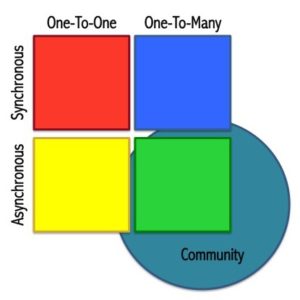New technologies can help professional services businesses to grow their business beyond billing hours of one-to-one client services. The one-to-one service model has dominated the professional service industry for years and the value proposition has been built around a richly personalized one-to-one real-time interaction. Like everything these days, technology has disrupted this model and created some new opportunities.
 One way to think about these opportunities is to group the types of client interactions and related technologies into four categories. The first group is One-To-One Synchronous. These are activities where you talk directly with your client in-person in real-time. Skype, Face Time, and other video-enabled services have now made it possible for even solo operators to have these face-to-face interactions globally without travel time. Nonetheless, there are only so many hours in the day you can bill with a one-to-one model.
One way to think about these opportunities is to group the types of client interactions and related technologies into four categories. The first group is One-To-One Synchronous. These are activities where you talk directly with your client in-person in real-time. Skype, Face Time, and other video-enabled services have now made it possible for even solo operators to have these face-to-face interactions globally without travel time. Nonetheless, there are only so many hours in the day you can bill with a one-to-one model.
The second group is One-To-One Asynchronous. By far the most common form of this type of professional service delivery is email. Email can still be personalized and responsive and it avoids telephone tag and intensive scheduling effort. In most cases, email has added some convenience, but it also tends to extend business hours to a growing expectation of 24 x 7 service. In some cases, email just means you are billing and working more hours.
Where the expectation of round the clock access is a part of the service, like medical practices, there is some promising experimentation going on with email between professionals and their clients and client portals that pull information into one place. There is definitely room for more innovation here. Still, you are limited to the number of people you can communicate with one-to-one in a day. The leverage you are getting is primarily from more efficiently managing one-to-one transactions.
Real business leverage only comes when you can figure out ways to enhance your business model with some of the One-To-Many strategies. Newsletters, podcasts, workshops, and presentations can deliver value to more clients at one time. An increasingly common path is recording a One-To-Many Synchronous event like a TED talk and using the high-quality audio and video as an entry point into the One-To-Many Asynchronous world of video blogs, podcasts, and YouTube.
The pre-internet version of this strategy was “writing and promoting a book.” This is still a good option for some professionals, especially if you can re-purpose the book’s content through social media channels and cross promote with blog posts and other “byte-sized” content that is easy for others to share. Another variation of this strategy, especially common with consulting firms, is to turn the most frequently requested advice into “products” that can be promoted and sold through subscription or used to draw potential clients into the top of the “engagement funnel.” All of these strategies make it possible to deliver services to more clients without being constrained to the number of hours in a day you have available to spend with each client one at a time.
The innovation frontier for many professional service businesses is the Community model. This is essentially a Many-To-Many Asynchronous model with some of the advantages of one-to-one, but the “one” isn’t always you the service provider. You create a platform where your clients get value from their membership in the community that you host and serve. It’s not just the logistics that Amazon figured out, but more importantly, the hosting of the customer reviews of everything under the sun combined with the conveniences of community membership and two-day delivery.
Professional services companies, whether sole proprietors or large firms, will continue to need a mix of strategies. Now would be a good time to analyze what strategies you are leveraging in each area and start systematically testing whether you have the right balamce and whether you are spending your resources in the right places.
It’s not just a matter of internal operational effectiveness. Clients will continue to want a personalized service, but increasingly they will expect to access that service on their own schedules on their preferred devices informed by the experience of other clients. Successful companies will find a way to leverage these new One-To-Many Asynchronous technologies to provide the services that their clients need. The best companies will also leverage these technologies to create a delivery model that ensures their employees aren’t stuck on a burn-out, billable-hour treadmill.
